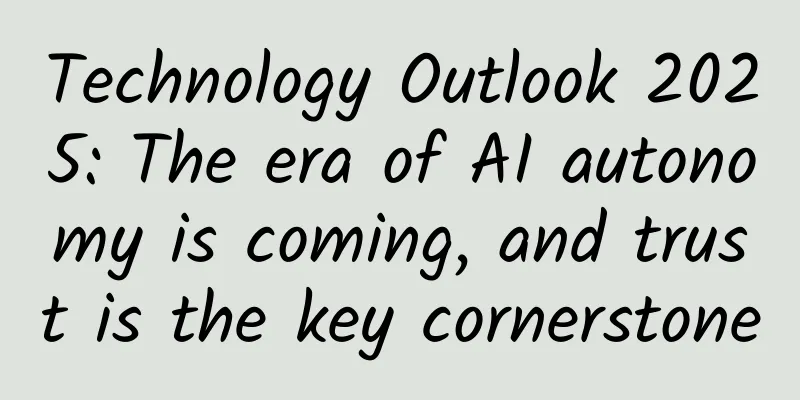Technology Outlook 2025: The era of AI autonomy is coming, and trust is the key cornerstone

|
The new era of AI autonomy and the urgency of enterprise reshaping: AI is driving enterprises to achieve unprecedented levels of autonomy through continuous learning, ushering in a new era of digitalization. The rapid popularization of AI has made corporate executives generally feel the urgency of reshaping their businesses and must rethink how to design, build and operate AI-driven technical systems and processes. Trust is the core premise for unleashing the potential of AI: Trust is the most important prerequisite for realizing the full potential of AI technology and reaping its huge benefits. This requires not only that companies use AI responsibly, but also that digital systems and AI models themselves have a high level of accuracy, predictability, consistency and traceability. Trust strategy must develop in tandem with technology strategy. Four key dimensions of AI reshaping the future: The report explores the potential far-reaching impact of generative AI (Gen AI) in the following four dimensions: Innovation in technology development: AI (such as AI coding assistants and intelligent agent systems) is changing the software development model, promoting the evolution from static applications to intent-based architectures and multi-agent systems, and accelerating the digitalization process of enterprises and the construction of customized systems. Reshaping customer experience: AI has become a new customer touchpoint. Companies need to go beyond general models and actively create personalized AI experiences that reflect brand culture and values in order to establish differentiated advantages. Intelligence of physical space: The integration of generative AI and robotics technology heralds the advent of highly autonomous general-purpose robots that can quickly learn new tasks and seamlessly collaborate and learn from human employees to improve efficiency and safety. Work organization changes: People and AI form a virtuous learning cycle, and AI can continue to learn and improve its skills to create long-term value for the organization. Companies need to ensure that employees have a positive relationship with AI, encourage employees to learn AI skills and use AI tools to improve their own capabilities. Key Stats: Sense of urgency for reinvention: Nearly seven in ten (69%) executives surveyed globally believe that the task of corporate reinvention is urgent. The importance of trust: 77% of global executives believe that AI can only bring real benefits if it is built on trust. Strategic synchronization: 81% of global executives noted that trust strategy must evolve in sync with technology strategy. Brand differentiation: While 80% of executives are concerned that large language models (LLMs) will homogenize brand voice, 77% believe that they can deliver unique brand value by creating personalized AI experiences. Trust in human-machine collaboration: 80% of executives believe that collaboration and mutual learning between robots and employees will enhance mutual trust and cooperation. Human-AI relationship management: 80% of executives believe that ensuring an active and positive relationship between employees and AI is one of their key priorities. Employee acceptance: Employees familiar with AI technology are five times more likely to have a positive view of the technology. The core idea is that artificial intelligence is entering a new stage of development characterized by "autonomy", and its ability to continuously learn and act autonomously will profoundly reshape corporate operations and even the entire society. To successfully navigate this change and fully unleash the huge potential of AI, establishing and maintaining "trust" is an indispensable cornerstone. Enterprises need to recognize the urgency of change, actively embrace AI, and strategically plan and reshape key areas such as technology development, customer interaction, physical space applications (robots), and future work models. At the same time, they must ensure the coordinated advancement of technology strategy and trust strategy, and pay attention to the harmonious symbiotic relationship between people and AI. The document link will be shared to 199IT Knowledge Planet. Scan the QR code below to view it! |
>>: Put your mirrorless camera aside and leave the professional photography to vivo X50 Pro!
Recommend
[Open Source & Sharing] Cocos Engine Chinese Official Website Tutorial Collection Order
The Cocos Engine Chinese official website is now ...
Plan an efficient marketing plan
In recent years, mobile Internet has developed ra...
From radicalism to ending and then chasing: the manned moon landing war between China, the United States and Russia
In the past two years, the most obvious feeling i...
How can designers quickly become competent in new jobs? Read this personal experience summary!
For most designers and design teams, they will en...
With the automated transaction of Shengfan traffic, I made 300-700 yuan a day
New project of Shengfan: Automated traffic transa...
Looking back | It was expelled from the "planet" 16 years ago, and it "made a heart" to you from 6 billion kilometers away
16 years ago, August 24, 2006, was destined to go...
Why is the shrub-covered "Roof of the World" a "forbidden zone" for trees?
Friends who have traveled to the Qinghai-Tibet Pl...
How are the App Store rankings determined? How to get on the top of the rankings
In the past two years, Xu Huaizhe and Liu Xiong h...
Practical information: A first look at the iOS 9 Contacts framework
[[155660]] iOS 9 shows many new technologies and ...
Guangzhou WeChat used car mini program function, how much does it cost to develop a used car trading mini program?
With the rise of "new energy" vehicles, ...
What are Tencent Video Ads? Introduction to the process of placing Tencent Video information stream ads!
What are Tencent Video Ads? Tencent Video is the ...
How much does it cost to develop a flash sale mini program in Shuangyashan?
How much does it cost to develop a Shuangyashan f...
Ocean stars, the beauty of the shell
Someone said: "There are as many shells in t...
To protect the ocean, scientists will observe shrimp populations from space | Environmental Trumpet
Hello everyone, this is the 28th issue of the Env...









